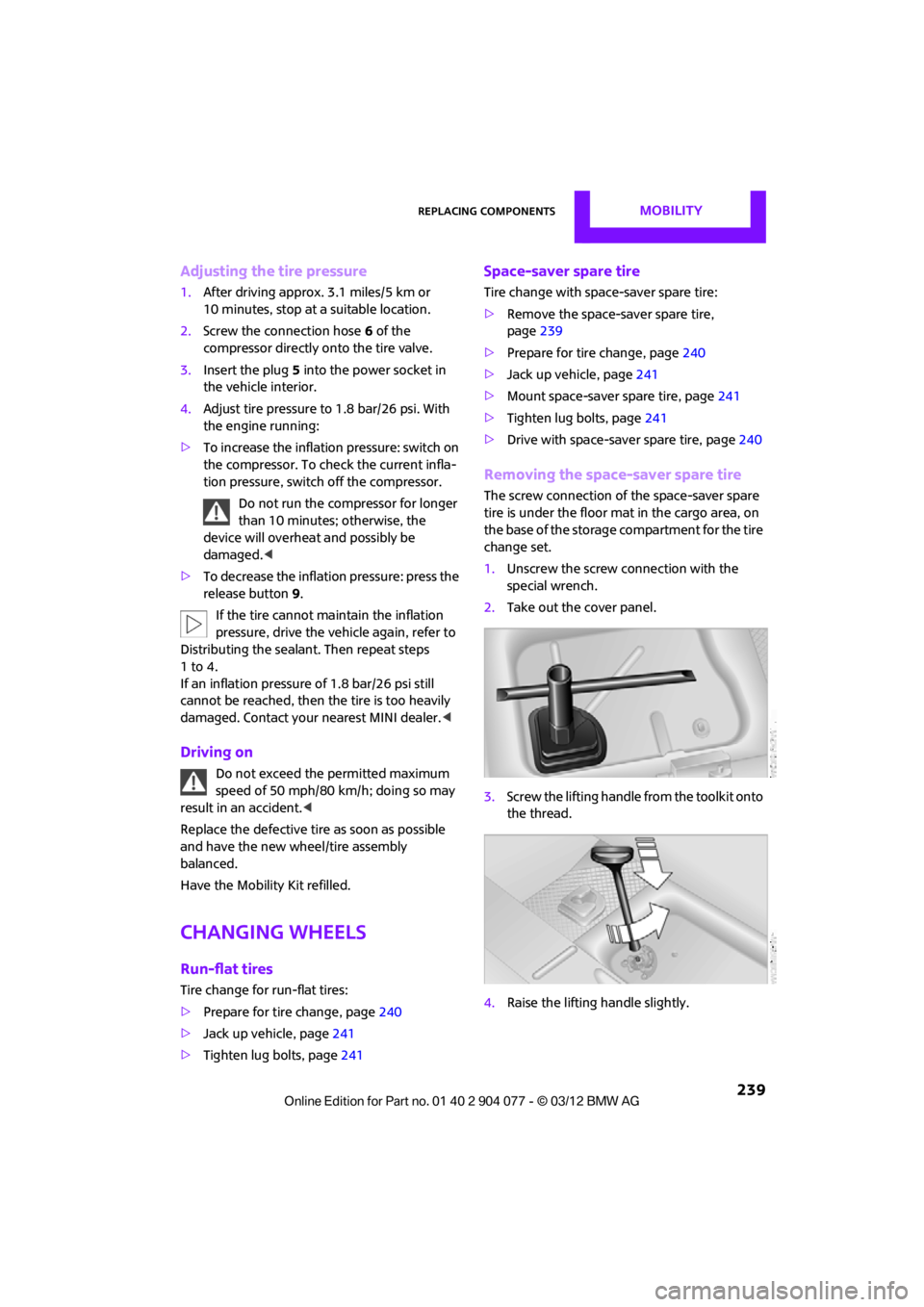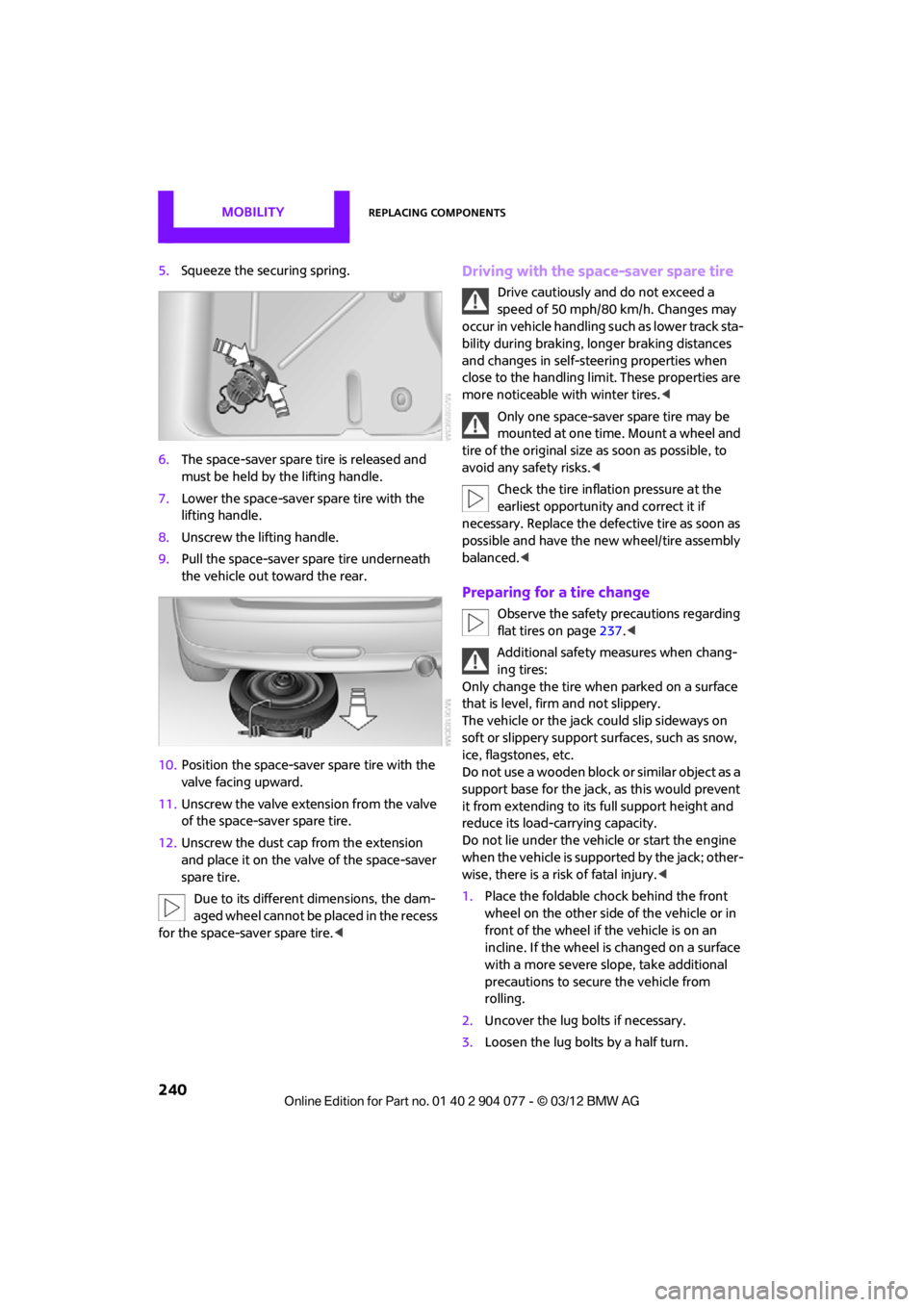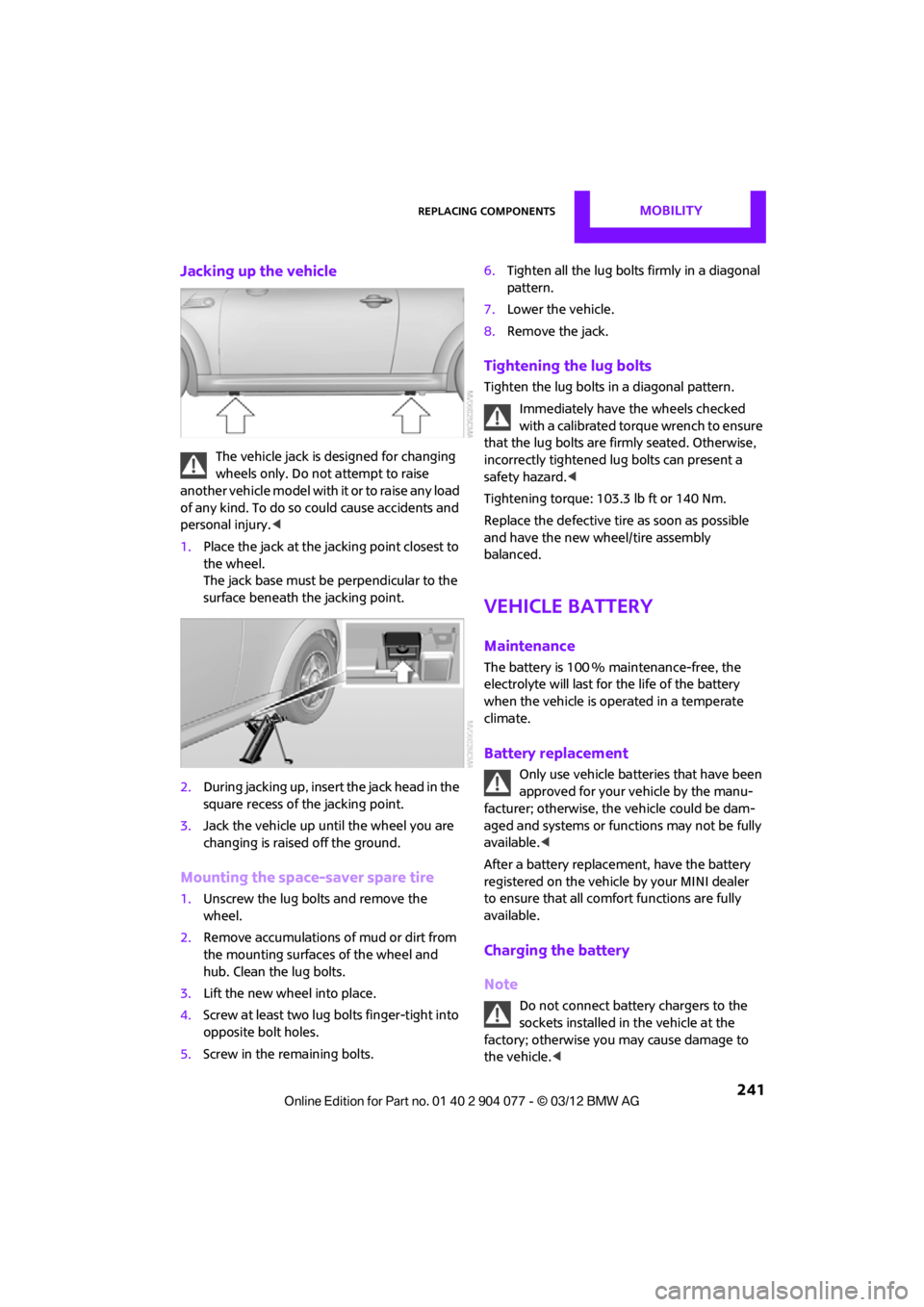wheel bolts MINI COUPE ROADSTER CONVERTIBLE 2012 Owners Manual
[x] Cancel search | Manufacturer: MINI, Model Year: 2012, Model line: COUPE ROADSTER CONVERTIBLE, Model: MINI COUPE ROADSTER CONVERTIBLE 2012Pages: 283, PDF Size: 9.38 MB
Page 240 of 283

Replacing componentsMOBILITY
239
Adjusting the tire pressure
1.After driving approx. 3.1 miles/5 km or
10 minutes, stop at a suitable location.
2. Screw the connection hose 6 of the
compressor directly onto the tire valve.
3. Insert the plug 5 into the power socket in
the vehicle interior.
4. Adjust tire pressure to 1.8 bar/26 psi. With
the engine running:
> To increase the inflatio n pressure: switch on
the compressor. To check the current infla-
tion pressure, switch off the compressor.
Do not run the compressor for longer
than 10 minutes; otherwise, the
device will overheat and possibly be
damaged. <
> To decrease the inflation pressure: press the
release button 9.
If the tire cannot ma intain the inflation
pressure, drive the vehicle again, refer to
Distributing the sealan t. Then repeat steps
1to4.
If an inflation pressure of 1.8 bar/26 psi still
cannot be reached, then the tire is too heavily
damaged. Contact your nearest MINI dealer. <
Driving on
Do not exceed the permitted maximum
speed of 50 mph/80 km/h; doing so may
result in an accident. <
Replace the defective tire as soon as possible
and have the new wheel/tire assembly
balanced.
Have the Mobility Kit refilled.
Changing wheels
Run-flat tires
Tire change for run-flat tires:
> Prepare for tire change, page 240
> Jack up vehicle, page 241
> Tighten lug bolts, page 241
Space-saver spare tire
Tire change with space-saver spare tire:
>Remove the space-saver spare tire,
page 239
> Prepare for tire change, page 240
> Jack up vehicle, page 241
> Mount space-saver spare tire, page 241
> Tighten lug bolts, page 241
> Drive with space-saver spare tire, page 240
Removing the space-saver spare tire
The screw connection of the space-saver spare
tire is under the floor mat in the cargo area, on
the base of the storage compartment for the tire
change set.
1. Unscrew the screw connection with the
special wrench.
2. Take out the cover panel.
3. Screw the lifting handle from the toolkit onto
the thread.
4. Raise the lifting handle slightly.
00320051004F004C00510048000300280047004C0057004C005200510003
Page 241 of 283

MOBILITYReplacing components
240
5.Squeeze the securing spring.
6. The space-saver spare tire is released and
must be held by the lifting handle.
7. Lower the space-saver spare tire with the
lifting handle.
8. Unscrew the lifting handle.
9. Pull the space-saver spare tire underneath
the vehicle out toward the rear.
10. Position the space-save r spare tire with the
valve facing upward.
11. Unscrew the valve extension from the valve
of the space-saver spare tire.
12. Unscrew the dust cap from the extension
and place it on the valve of the space-saver
spare tire.
Due to its different dimensions, the dam-
aged wheel cannot be placed in the recess
for the space-saver spare tire.
speed of 50 mph/80 km/h. Changes may
occur in vehicle handling such as lower track sta-
bility during braking, longer braking distances
and changes in self-steering properties when
close to the handling limit. These properties are
more noticeable with winter tires. <
Only one space-saver spare tire may be
mounted at one time. Mount a wheel and
tire of the original size as soon as possible, to
avoid any safety risks. <
Check the tire inflation pressure at the
earliest opportunity and correct it if
necessary. Replace the defe ctive tire as soon as
possible and have the ne w wheel/tire assembly
balanced. <
Preparing for a tire change
Observe the safety precautions regarding
flat tires on page 237.<
Additional safety measures when chang-
ing tires:
Only change the tire wh en parked on a surface
that is level, firm and not slippery.
The vehicle or the jack could slip sideways on
soft or slippery support surfaces, such as snow,
ice, flagstones, etc.
Do not use a wooden block or similar object as a
support base for the jack, as this would prevent
it from extending to its full support height and
reduce its load-carrying capacity.
Do not lie under the vehicle or start the engine
when the vehicle is supported by the jack; other-
wise, there is a risk of fatal injury. <
1. Place the foldable chock behind the front
wheel on the other side of the vehicle or in
front of the wheel if the vehicle is on an
incline. If the wheel is changed on a surface
with a more severe sl ope, take additional
precautions to secure the vehicle from
rolling.
2. Uncover the lug bolts if necessary.
3. Loosen the lug bolts by a half turn.
00320051004F004C00510048000300280047004C0057004C005200510003
Page 242 of 283

Replacing componentsMOBILITY
241
Jacking up the vehicle
The vehicle jack is designed for changing
wheels only. Do not attempt to raise
another vehicle model with it or to raise any load
of any kind. To do so could cause accidents and
personal injury. <
1. Place the jack at the jacking point closest to
the wheel.
The jack base must be perpendicular to the
surface beneath the jacking point.
2. During jacking up, insert the jack head in the
square recess of the jacking point.
3. Jack the vehicle up until the wheel you are
changing is raised off the ground.
Mounting the space-saver spare tire
1.Unscrew the lug bolts and remove the
wheel.
2. Remove accumulations of mud or dirt from
the mounting surfaces of the wheel and
hub. Clean the lug bolts.
3. Lift the new wheel into place.
4. Screw at least two lug bolts finger-tight into
opposite bolt holes.
5. Screw in the remaining bolts. 6.
Tighten all the lug bolts firmly in a diagonal
pattern.
7. Lower the vehicle.
8. Remove the jack.
Tightening the lug bolts
Tighten the lug bolts in a diagonal pattern.
Immediately have the wheels checked
with a calibrated torque wrench to ensure
that the lug bolts are firmly seated. Otherwise,
incorrectly tightened lug bolts can present a
safety hazard. <
Tightening torque: 103.3 lb ft or 140 Nm.
Replace the defective tire as soon as possible
and have the new wheel/tire assembly
balanced.
Vehicle battery
Maintenance
The battery is 100 % maintenance-free, the
electrolyte will last for the life of the battery
when the vehicle is operated in a temperate
climate.
Battery replacement
Only use vehicle batteries that have been
approved for your vehicle by the manu-
facturer; otherwise, the vehicle could be dam-
aged and systems or func tions may not be fully
available. <
After a battery replacement, have the battery
registered on the vehicle by your MINI dealer
to ensure that all comfort functions are fully
available.
Charging the battery
Note
Do not connect battery chargers to the
sockets installed in the vehicle at the
factory; otherwise you may cause damage to
the vehicle.<
00320051004F004C00510048000300280047004C0057004C005200510003
Page 280 of 283

Everything from A to ZREFERENCE
279
T
Tachometer70
Tailgate 33
– Comfort Access 37
– emergency operation 34
– emergency unlocking 34
– manually releasing 33
– opening/closing 33
– opening from outside 33
– unlocking with remote control 31
Tail lamp, refer to Tail
lamps 235
– replacing bulb 235
Tail lamps 235
Tank volume, refer to Capacities 259
Target cursor for
navigation 131
Tasks 198
Technical data 250
Technical modifications 5
Telephone
– hands-free system 177,189
– installation location, refer to Center armrest 108
– voice commands 189
Telephone receiving power, refer to Status
information 21
Temperature display
– setting the units 74
Temperature of coolant, refer to Coolant temperature 224
Temperature setting
– air conditioner 103
– automatic climate control 105
Tempomat, refer to Cruise control 68
Tensioning straps, refer to
Securing cargo 119
Text message 196
Third brake lamp, refer to
Center brake lamp 236
Three-point safety belt 53Tightening the lug bolts
– keys
231
– torque 241
Tightening torque, refer to
Tightening lug bolts 241
Tire change set
– space-saver spare tire 231
Tire failure
– Flat Tire Monitor 88
– indicator/warning lamp 88
– MINI Mobility Kit 237
– run-flat tires 88
– space-saver spare tire 239
– Tire Pressure Monitor 89
Tire inflation pressure 209
– loss 88,
89
– spac
e-saver
spare tire 209
Tire pressure mo nitoring, refer
to Flat Tire Monitor 87
Tire Pressure Monitor TPM 89
– limitations of system 89
– resetting system 90
– warning lamp 90
Tire Quality Grading 217
Tires
– age 218
– breaking in 114
– changing, refe r to Changing
wheels 239
– condition 217
– damage 217,218
– inflation pressure 209
– inflation pressure loss 90
– minimum tread depth 218
– new tires 219
– pressure monitoring, refer to
Flat Tire Monitor 87
– pressure monitoring, refer to Tire Pressure Monitor
TPM 89
– puncture 88
– size 216
– wear indicators, refer to Minimum tread depth 218
– winter tires 220
– with emergency operation properties 218 Tires with emergency
operation properties, refer to
Run-flat tires 218
Tires with safety features, refer
to Run-flat tires 218
TMC station, refer to Traffic information 139
Tone
– middle setting 148
Tone during audio playback
– adjusting 147
Toolkit 231
Tools, refer to Toolkit 231
Torque 250
– lug bolts 241
Tow bar 245
Tow fitting 245
– screw thread 245
Tow fittings for tow-starting
and towing away 245
Towing 244
– car with automatic
transmission 245
– methods 245
Tow rope 246
Tow-starting 244
TPM, refer to T
i
re Pressure
Monitor 89
Track
– selecting on CD 157
Track width, refer to Dimension 251
Traction control, refer to
– Dynamic Stability Control DSC 83
Traffic bulletins
– categories 141
Traffic bulletins, filtering 141
Traffic congestion
– displaying traffic information 139
– refer to Route, bypassing
segments 136
Traffic information for navigation
– displaying 140
00320051004F004C00510048000300280047004C0057004C005200510003